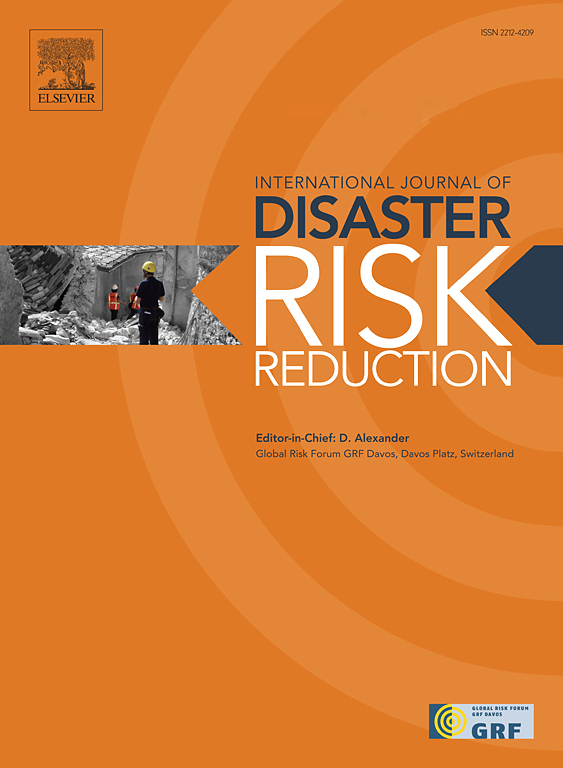Geohazard types, households’ behavioral decision-making, and livelihood strategies: Empirical evidence from Southwest China
IF 4.2
1区 地球科学
Q1 GEOSCIENCES, MULTIDISCIPLINARY
International journal of disaster risk reduction
Pub Date : 2025-02-28
DOI:10.1016/j.ijdrr.2025.105360
引用次数: 0
Abstract
Households' behavioral decision-making is critical for disaster prevention and mitigation, and also strengthening settlement resilience. To investigate the relationship between geohazard types and behavioral decision-making, this study focused on landslides and debris flow in Southwest China's mountainous regions. Using random sampling, 63 villages threatened by two different geohazard types in Chongqing and Sichuan were studied, then 1019 sample questionnaires in total were kept. We used statistical methods to analyze differences in households' individual characteristics and behavioral decision-making as a result of different geohazard types. Propensity score matching was used to determine whether different geohazards varied the behavioral decision-making of households. There were four main findings. (1) Following model fitting, the sample's mean absolute deviation reduced from 56 % before matching to 4.9 %, demonstrating that the kind of geohazard has an important effect in behavioral decisions, after controlling for other variables. (2) Peer effects in relocation behavior regardless of the type of geohazard threat to the household(ATT = 0.0098,P > 0.1). (3) Various geohazard characteristics resulted in different behavioral decisions, and different behavioral decisions reflected the characteristics of multiple geohazards. (4) Different geohazards had different attributes, and households had diverse perceptions and impressions of them, leading to differences in behavioral decision-making. From a micro perspective, this study focuses on households' behavioral decision-making in disaster prevention under the influence of various types of geohazards, confirming that people's behavioral decision-making is influenced by geohazard type, which contributes to the theoretical discussion of disaster prevention behavior in academia and provides a richer perspective for bottom-up disaster risk governance.
家庭的行为决策对于防灾减灾和增强住区抗灾能力至关重要。为探究地质灾害类型与行为决策之间的关系,本研究以中国西南山区的滑坡和泥石流为研究对象。我们采用随机抽样的方法,对重庆和四川两地受到两种不同地质灾害类型威胁的 63 个村庄进行了调查,共回收问卷 1019 份。我们采用统计方法分析了不同地质灾害类型对家庭个体特征和行为决策的影响。采用倾向得分匹配法确定不同地质灾害是否会改变家庭的行为决策。主要发现有四点(1) 模型拟合后,样本的平均绝对偏差从匹配前的 56% 降至 4.9%,表明在控制其他变量后,地质灾害类型对行为决策有重要影响。(2) 无论家庭受到哪种地质灾害的威胁,搬迁行为都会受到同伴效应的影响(ATT = 0.0098,P > 0.1)。(3)不同的地质灾害特征导致不同的行为决策,不同的行为决策反映了多种地质灾害的特征。(4)不同的地质灾害具有不同的属性,住户对地质灾害的认知和印象也不尽相同,从而导致行为决策的差异。本研究从微观视角出发,关注不同类型地质灾害影响下家庭的防灾行为决策,证实了人们的行为决策受地质灾害类型的影响,有助于学术界对防灾行为的理论探讨,为自下而上的灾害风险治理提供了更丰富的视角。
本文章由计算机程序翻译,如有差异,请以英文原文为准。
求助全文
约1分钟内获得全文
求助全文
来源期刊

International journal of disaster risk reduction
GEOSCIENCES, MULTIDISCIPLINARYMETEOROLOGY-METEOROLOGY & ATMOSPHERIC SCIENCES
CiteScore
8.70
自引率
18.00%
发文量
688
审稿时长
79 days
期刊介绍:
The International Journal of Disaster Risk Reduction (IJDRR) is the journal for researchers, policymakers and practitioners across diverse disciplines: earth sciences and their implications; environmental sciences; engineering; urban studies; geography; and the social sciences. IJDRR publishes fundamental and applied research, critical reviews, policy papers and case studies with a particular focus on multi-disciplinary research that aims to reduce the impact of natural, technological, social and intentional disasters. IJDRR stimulates exchange of ideas and knowledge transfer on disaster research, mitigation, adaptation, prevention and risk reduction at all geographical scales: local, national and international.
Key topics:-
-multifaceted disaster and cascading disasters
-the development of disaster risk reduction strategies and techniques
-discussion and development of effective warning and educational systems for risk management at all levels
-disasters associated with climate change
-vulnerability analysis and vulnerability trends
-emerging risks
-resilience against disasters.
The journal particularly encourages papers that approach risk from a multi-disciplinary perspective.
 求助内容:
求助内容: 应助结果提醒方式:
应助结果提醒方式:


